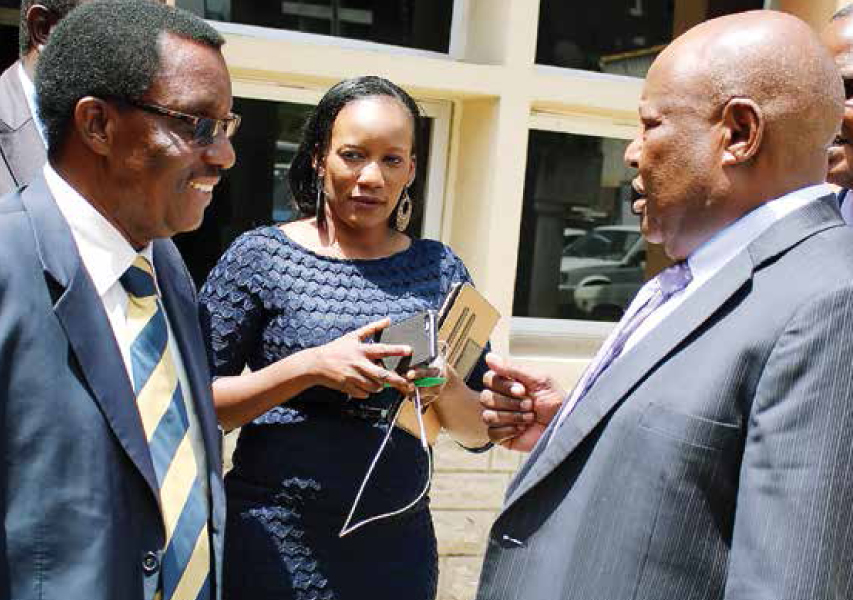
Prior to his appointment as Minister for Tourism and Wildlife in 2005, Morris Mwachondo Dzoro was the Assistant Minister for Public Service. His rise to the helm of the Tourism and Wildlife docket came through rather tragic circumstances as his predecessor, Emmanuel Karisa Maitha, had died suddenly on 27 August 2004. Maitha was not your commonplace politician. Popularly known as ‘The Hurricane’, the burly, aggressive yet gregarious personality was President Mwai Kibaki’s highly reliable ally who helped him repulse the influence of political adversaries in the Coast region. When he died, Kibaki picked Dzoro to replace him. At the time, Dzoro was also the Member of Parliament for Kaloleni Constituency in Coast Province, winning the seat from the Kenya African National Union (KANU) party’s Mathias Benedict Keah in the 2002 General Election. Before then he had worked for World Vision-Kenya in various capacities besides working as a part-time lecturer at the University of Nairobi and Daystar University.
Political pundits agree that Kibaki’s choice was largely influenced by Dzoro’s ethnic Mijikenda roots – it was intended to demonstrate that the President had not abandoned the region after Maitha’s death. At the same time, this act of inclusion ensured that the Mijikenda retained their slot in the Cabinet.
Popularly known as ‘The Hurricane’, the burly, aggressive yet gregarious personality was President Mwai Kibaki’s highly reliable ally who helped him repulse the influence of political adversaries in the Coast region.
Tourism was a critical sector in Kibaki’s economic revival plan and it fell on the Minister to align his operations at the ministry to the vision of the Kibaki administration. To help him realise this were Raphael Muriungi, the Assistant Minister for Tourism, and Kalembe Ndile, who was the Assistant Minister for Wildlife.
The main highlight of Dzoro’s efforts was his initiation of the wildlife conservation and management policy review. In a speech he gave on 3 March 2006, he clarified the factors that necessitated the review, saying he was convinced it would help scale down cases of human-wildlife conflicts in wildlife conservation areas. In particular, the policy review aimed to solve contentions that arose out of the need for compensation for deaths, injuries or destruction of property communities suffered due to wildlife invasion. The speech revealed Dzoro’s keenness to strike a balance between human rights and protection of wildlife. Rather than merely mitigating human-wildlife conflict, his approach focused on the root causes of this problem.
For whatever reason, the wildlife conservation and management policy review process did not go the full distance during Dzoro’s tenure. Its product – the Wildlife Conservation and Management Act 2013 – came into force in January 2014, many years after he had exited the ministry. Nonetheless, it is thanks to this law that Kenya can take pride in improved protection, conservation, and sustainable use and management of wildlife resources. In addition, the Act has helped contain the loss of wildlife that had shot up alarmingly despite robust conservation efforts. Dzoro had attributed this escalation to a mixture of policy, institutional and market failures. The new law also changed the way wildlife resources are managed by separating regulation and management functions from research. As such, it laid ground for community-based wildlife management while also rooting for equitable sharing of any benefits accrued from wildlife resources by Kenyans.
Moreover, the law advocated for the use of an ecosystem approach in wildlife management and sustainable utilisation of natural resources, and encouraged wildlife conservation and management as a form of land use on public, community and private land. It also granted individuals the right to practise wildlife conservation and prescribed stiffer penalties for poachers. During his tenure, Dzoro also ran vibrant marketing campaigns to promote
Kenya as a tourist destination. Part of his strategy was the branding of key tourist sites in the country, including Aberdare National Park, one of Kenya’s major forest conservation sites. Others were Lake Nakuru, Amboseli and
Tsavo East and West national parks. Perhaps it was this sustained marketing campaign that resulted in the Kenya
Wildlife Service hitting their KES 1.9 billion target three months ahead of time in 2007.
Dzoro was a strong supporter of a complete shift in the approach to tourism marketing. He wanted African countries to pool resources and efforts to promote the continent as a single tourist destination. His proposal was that Africa should institute the African Travel Association, an outfit that would supplement traditional marketing approaches.
In a bid to professionalise the tourism sector, the Minister formed the Hotels and Restaurants Authority Board whose mandate was to inspect and help standardise hotels, lodges and other tourist facilities in East African countries. The Board was also meant to ensure there was enough qualified personnel to oversee daily operations in the industry.
Keen to position Kenya as the prime tourist destination in the region, Dzoro also insisted on the development of the sector in a way that allowed the sustainability and utilisation of natural and cultural resources. During his last days in the ministry, Dzoro oversaw the return to Kenya from the United States of America of artefacts that had been stolen two decades previously. The artefacts, among them unique woodcarvings that were highly coveted on the international African art market, were returned to Chalani Village in Kilifi District in June 2007. Dzoro’s stint at the helm of the Ministry of Tourism and Wildlife had its fair share of ups and downs. One of these was a power tussle between him and his Assistant Minister, Ndile, who accused him of high-handedness and complained that Dzoro took him for granted and treated him like a shadow. He said he often learnt of ministry policy decisions from the press.

In a move that elicited surprise and criticism, Dzoro supported the downgrading of Amboseli National Park to a game reserve. As soon as President Kibaki assented to the proposal, Dzoro issued a special Kenya Gazette notice that put Amboseli National Reserve under the management of Ol Kejuado County Council. The Minister’s failure to facilitate public participation on such a move was frowned upon and cited as a breach of the law. In fact, political analysts read political mischief, saying the move was a ploy to lure the Maasai community into voting a certain way during the 2005 referendum to change the Constitution of Kenya. In his response to these allegations, Dzoro invoked the Wildlife Conservation and Management Act and denied playing politics. Whatever the case, the local communities, through their leaders, lauded his move.
Another incident that brought Dzoro under stinging criticism was the Kenya- Thailand deal that almost saw Kenya export wild animals to Thailand. On 9 November 2005, Dzoro and Yungyut Tiyapairat, Thailand’s Minister for Natural Resources and Environment at the time, signed a deal to transfer 300 wild animals from Kenya to Thailand. President Kibaki and Thailand’s Prime Minister, Thanksin Shinawatra, witnessed this signing away of white rhinos,
lions, leopards, warthogs and cheetahs. Thailand would keep the animals at its Chiang Mai Night Zoo. Protests broke out immediately after the deal was signed. So volatile was the situation that the Thai Prime Minister reportedly had to be smuggled out of Village Market, the upmarket shopping mall in Nairobi that was the venue of the signing ceremony.
Wildlife conservation groups went to court to have the agreement overturned, citing Thailand’s reputation for cruelty towards wild animals. Coincidentally, a year before the deal was signed, more than 100 tigers had died in Thailand,
reportedly in the privately-owned Sri-Racha tiger zoo. It was alleged that the animals died after they were fed chickens contaminated with bird flu, and there were fears that any animals exported from Kenya could also become
infected. The protestors also argued that elephant handlers in Thailand used unnecessarily cruel techniques that could not be used on fiercer African elephants. International wildlife conservation groups joined in, imploring Kibaki to revoke the agreement while pointing out that the deal would dent Kenya’s image as an animal-friendly tourist destination. Still others threatened Kenya with sanctions. Pan-African Sanctuaries Alliance, for example, said it would reconsider plans to hold its 2005 workshop in Kenya if the government went ahead with the animal export deal. In a letter to the Ministry of Tourism and Wildlife and the Kenya Wildlife Service, Pan-African Sanctuaries Alliance faulted Kenya’s understanding of the wildlife situation in Kenya, East Africa and Africa at large. It reminded Kenya of the ripple consequences of decisions on wildlife, pointing out that such decisions could have negative impacts notonly on tourism but also commerce and trade.
In a counter argument, the ministry explained to citizens that the purpose of the deal was to strengthen diplomatic ties between the two countries. Further, the ministry downplayed the agreement, saying it was mostly aimed at helping Kenya get rid of some of its over-populated animal species without necessarily killing them. Thailand on the other hand insisted that the animals were not purchases but a means through which to conduct mutually beneficial research and to prevent the killing of Kenya’s excess wildlife populations.
In the end, however, the animal export agreement was overturned by a Kenyan court. As Minister, Dzoro refused to let international travel advisories against Kenya bother him. In June 2005, for instance, there were fears that a military aid row between Kenya and the US would hurt Kenya’s tourism sector. Dzoro came out to reassure the country that America’s suspension of KES 760 million in military aid was inconsequential to the tourism sector. He argued that it was not right for the US to bulldoze Kenya into signing a bilateral treaty that would cushion US soldiers from charges stemming from any international war crimes they might commit. He attributed the hike in
Kenya’s tourism profits to American tourists’ defiance of their government’s travel advisories against Kenya.
Moreover, there were growing contacts between Kenya and Far Eastern tourist markets such as China, South Korea
and Japan. In the 2007 General Election, Dzoro lost his Kaloleni parliamentary seat to Kazungu Kambi in a wave that saw politician Raila Odinga’s Orange Democratic Movement party stamp its influence in the Coast region. Born on 5 December 1950, Dzoro attended Pangani Primary School between 1959 and 1965. In 1989, he graduated from Messiah College in the US with a Bachelor of Arts degree in Community Development. He also has a Master of Arts in Theology and Development Studies from Leeds University in the UK as well as a certificate in leadership from Haggai Institute in Singapore and a diploma in communication from Daystar University (Kenya).
In the years since he lost the election, Dzoro served as a commissioner with the National Cohesion and Integration Commission. Due to his knowledge and experience in leadership, peace building, conflict resolution and inter- sector partnerships, he enjoyed a pronounced presence in the commission. He has remained a notable figure in Coast region politics and apart from opposing calls for secession of the Coast region, he has been vocal and categorical in urging Kenyans to shun post-election violence as expressed in an opinion article titled Never again should Kenyans fight, published in The Standard newspaper on 31 January 2017.
